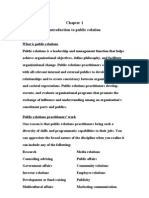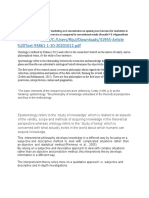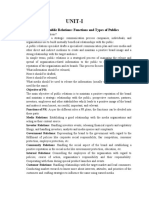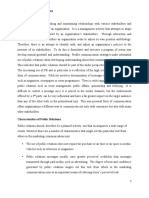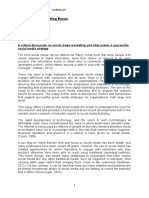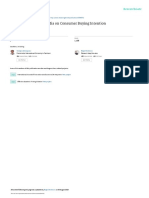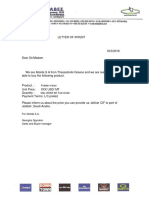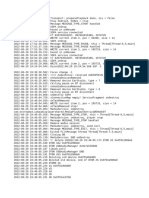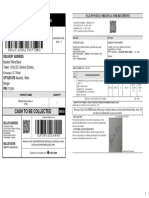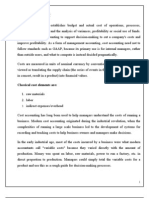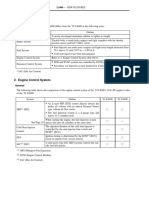0 ratings0% found this document useful (0 votes)
54 viewsMedia Monitoring Slide
Media Monitoring Slide
Uploaded by
gelfeto gebreThe documents discuss the purpose and benefits of media monitoring for public relations and organizations. Media monitoring allows organizations to track what the media is saying about them, their competitors, and their industry. It provides insights and analysis that help organizations understand audience feelings, the current environment, and inform future strategies. Media monitoring services can save PR teams time by automating repetitive tasks like daily media searches. They also provide actionable insights through in-depth analysis and real-time alerts to help mitigate potential crises.
Copyright:
© All Rights Reserved
Available Formats
Download as PPTX, PDF, TXT or read online from Scribd
Media Monitoring Slide
Media Monitoring Slide
Uploaded by
gelfeto gebre0 ratings0% found this document useful (0 votes)
54 views37 pagesThe documents discuss the purpose and benefits of media monitoring for public relations and organizations. Media monitoring allows organizations to track what the media is saying about them, their competitors, and their industry. It provides insights and analysis that help organizations understand audience feelings, the current environment, and inform future strategies. Media monitoring services can save PR teams time by automating repetitive tasks like daily media searches. They also provide actionable insights through in-depth analysis and real-time alerts to help mitigate potential crises.
Copyright
© © All Rights Reserved
Available Formats
PPTX, PDF, TXT or read online from Scribd
Share this document
Did you find this document useful?
Is this content inappropriate?
The documents discuss the purpose and benefits of media monitoring for public relations and organizations. Media monitoring allows organizations to track what the media is saying about them, their competitors, and their industry. It provides insights and analysis that help organizations understand audience feelings, the current environment, and inform future strategies. Media monitoring services can save PR teams time by automating repetitive tasks like daily media searches. They also provide actionable insights through in-depth analysis and real-time alerts to help mitigate potential crises.
Copyright:
© All Rights Reserved
Available Formats
Download as PPTX, PDF, TXT or read online from Scribd
Download as pptx, pdf, or txt
0 ratings0% found this document useful (0 votes)
54 views37 pagesMedia Monitoring Slide
Media Monitoring Slide
Uploaded by
gelfeto gebreThe documents discuss the purpose and benefits of media monitoring for public relations and organizations. Media monitoring allows organizations to track what the media is saying about them, their competitors, and their industry. It provides insights and analysis that help organizations understand audience feelings, the current environment, and inform future strategies. Media monitoring services can save PR teams time by automating repetitive tasks like daily media searches. They also provide actionable insights through in-depth analysis and real-time alerts to help mitigate potential crises.
Copyright:
© All Rights Reserved
Available Formats
Download as PPTX, PDF, TXT or read online from Scribd
Download as pptx, pdf, or txt
You are on page 1of 37
Purpose of the course
To introduce for what reason media monitoring
is conducted and why different organizations
monitor media?
To know how media work?
To understand the audience feeling, wants and
desires?
To realize the current environment and design
strategy for the future.
Academic Media Monitoring
Alongside the continuing global expansion of
connectivity, ecological degradation, and social
media, more recent events – such as the global
economic downturn and changing public attitudes
to business – are creating different operating
conditions. Academically, the rise of different
voices in journals, books, and research has been
paralleled by the declining power of the ruling
paradigm of late 20th century public relations.
Academic media (cont.)
The old center has not held and a diversity of
opinion that is less limited, and more socially
concerned, continues to emerge. These newer
voices differ on perceptions of present, past, and
future – not only are there disagreements on
what public relations is now, but on what public
relations has been, and on what public relations
might be.
Academic media (cont.)
At the World Public Relations Forum (2010) in
Sweden, authors of the Stockholm Accords drew
upon public relations and communication
management (PR/CM) theory and best practices
to define, recommend, and promulgate
performance standards to foster the
“communicative organization” (CO) as vital to
achieving sustainability.
Academic media (cont.)
That project is challenging for several reasons.
(1) All too frequently, academics and practitioners do not
collaborate to solve daunting professional problems, let
alone one that has societal implications this vast.
(2) The Accords, as a companion to Vision 2050 (World
Business Council for Sustainable Development, 2010),
framed the challenge as one confronting management
policies along with requirements of the CO. PR/CM can
help achieve sustainability by making organizations more
communicative as a precondition toward sustainability.
Academic media (cont.)
To do so, the current emphasis on processes of
communication needs to shift to future
discourse, shared (co-created) meaning, and
the agency of society as a force for collaborative
decision making. The challenge before us as
academics and professionals is to assure that the
communication effort to achieve sustainability
is sufficiently grounded to achieve that mission
and vision
Why media monitoring?
Producing proper media-monitoring reports are essential
for PR specialists as well as for media-researchers. As for
Journalists and associates, they can apply this research
based knowledge to become more result-oriented.
what are the elements that exist in the story or event and
cause positive or negative media reflection, framing of the
news?
1: The elements that influence on media tone are in
correlation with each other and the more
elements/symbols exist in the story, the more influence
they have on media-coverage.
Why media monitoring? (cont.)
2: These elements might be used during event-
planning, agenda-setting for adjusting the
media stance of the relevant organization and
framing the positive or negative media-
positioning.
3: There could be some correlation between the
relevant organization’s pro activeness, which
shapes the organization’s niche in the media, and
the negative news niche about the organization.
Why media monitoring? (cont.)
The objective of surveillance is “to promptly
identify and deal with the opportunities and risks
that can impact the organization’s direction, action
and communication”. Each organization’s
governance is to have solid issue monitoring
functions and structures to be able to read and
adapt to changing sociopolitical conditions that
define its operating environment. Each organization
is expected to listen, adapt, and adjust.
Why media monitoring? (cont.)
PR/CM must be prepared to engage in socially
constructive discourse in a manner that joins
and aligns the views of clients/employers and
other voices. Discourse is a means by which
voices pit ideas against one another, as
statement and counter statement. Through
discourse, ideas are publicly advanced and
weighed leading optimally to enlightened choice
Why media monitoring? (cont.)
An undercurrent to theory must examine how
we know (and how well) reality, how we
conceptualize ourselves (identification), and
how we organize into society (between) as
aligned and competing interests and identities.
These themes can never be separated from
challenges of sound science and reflective
management—as keys to a genuine public
interest embraced by the goal of sustainability.
In this way, Fully Functioning Society Theory
(FFST) reasons that society is a complex of many
collectivities, each of which has its own, but
interdependent and variously aligned interests.
The role of public relations is to help create and
advance the infrastructures and co-create
meanings that bring these interests into
alignment. This rationale matures into one of
the key premises of the theory:
Function of PR
To help society to become more fully functioning,
managements of organizations (for profit, nonprofit, and
governmental) must demonstrate the characteristics that
foster legitimacy, such as being reflective; being willing
to consider and instrumentally advance others’ interests;
being collaborative in decision making; being proactive
and responsive to others’ communication and opinion
needs; and working to meet or exceed the requirements
of relationship management, including being a good
corporate citizen.
Media Monitoring for PR
Media monitoring services can help PR teams save
time on important but repetitive and everyday tasks.
Here are some of our recommendations.
Nearly half of all PR practitioners claim that
tracking news clippings and media mentions is
an integral part of their work. However,
running daily web searches for your clients and
staying on top of Google Alerts — while important
that can be a distracting and everyday endeavor.
Media Monitoring for PR (cont.)
Media monitoring services allow
marketers and PR teams to track (foot-
path) what the media (print, broadcast, and
online) is saying about a brand, its
competitors, and the industry at large.
Today, we can use sophisticated
procedures, artificial intelligence, machine
learning, and automated tools to monitor
media.
Media Monitoring for PR (cont.)
Media monitoring services can benefit PR teams in
the following ways:
• Save time by automating a repetitive activity.
• Provide actionable insights via detailed analysis of
coverage, complete with graphs, charts, and maps.
• Get real-time alerts to help mitigate a crisis early,
and not let it get out of hand.
• Identify potential journalists and influencers for
media outreach.
There are plenty of data available every day in
social media, however how to utilize this data
and provide insight into the organization in order
to improve their performance in the market is a
question for every organization.
Why Monitor the Media?
• Analysis of information published in the
media is an important tool. Information that is
collected and properly aggregated contributes
to the assessment of companies’ projects and
allows to observe and to evaluate changes
occurring in the environment.
Why Monitor the Media?
Key Tool for Public Relations, Marketing &
Competitive Intelligence
Media monitoring is the process of reading,
watching or listening to the editorial
content of media sources on a continuing
basis, and then, identifying, saving and
analyzing content that contains specific
keywords or topics.
Why Monitor the Media?
Monitoring editorial content of news sources
including newspapers, magazines, trade journals, TV,
radio stations and the Internet is by far the most
common type of media monitoring. This form of media
monitoring is called “news monitoring.”
In addition to monitoring news, many organizations
now also monitor social-media on the Internet,
tracking word of mouth mentions about their
organization in social media such as Facebook,
Twitter, blogs, message boards and
forums. This is commonly known as social media
monitoring, word-of-mouth monitoring, or telephone
call monitoring.
Media monitoring (cont.)
• Today’s companies undertake a number of
analytic efforts, which allows them to gain the
knowledge required to support their
management processes. Special attention is
given to areas such as marketing or public
relations because many managers, when
determining their next steps in those areas, need
to know whether their previous decisions were
beneficial.
Media monitoring (cont.)
• By analyzing marketing and public relations activity, they
can determine whether the budget was properly planned,
whether a plan was successfully implemented and whether
the expenses incurred have paid off. This is why companies
deploy media monitoring, defined as a process of reading,
watching and listening to source content for keywords that
appear in media and then aggregating these materials . 3
Media monitoring is being used by more and more entities
as it aggregates and provides information about what was
published in the media, with a focus on the content
(Milivojevic, 2003, p.16).
Media monitoring (cont.)
• It sheds light on people’s feelings and expectations (Gawroński,
2006, p.10). The purposes of media monitoring are clear as they
involve obtaining knowledge, but they can also vary. The process
itself requires appropriate selection of methods.
• Monitoring can pursue quantitative or qualitative analysis, for
example, by focusing on evaluating news narratives (Gawroński,
2006, p.16). Everything in this area depends on the entity
undertaking the study as well as the purpose of the analysis.
• Many companies, government agencies, non-profit organizations
Media monitoring (cont.)
Many companies, government agencies, non-
profit organizations (e.g. hospitals, universities,
associations etc.) and individuals, e.g. celebrities,
use media monitoring as a tool for tracking
mentions about themselves in the news media.
Some entities monitor media to assess the effect
of their publications but also to gather intelligence
on their competitors and specific important
issues from their organisation’s standpoint
(Comcowich, 2010, p.3).
Media monitoring (cont.)
Searching for information published in the media
is a guarantee of obtaining accurate information
that supports certain management processes. It
helps you understand your target audience but
also, in particular, the information that journalists
are seeking. Media monitoring and the
associated data analysis support at every step of
the way the company’s PR efforts, while also
assisting with identifying any potential perception
crises.
Media monitoring (cont.)
Data obtained through media monitoring helps
assess the effectiveness of PR efforts and
supports rapid response strategies. It provides
a database for management processes.
Monitoring can include a wide range of
traditional and modern media, including
specific channels that require outreach to
consumers such as news services, message
boards, blogs and social media platforms
such as Facebook, Twitter or LinkedIn.
Media monitoring (cont.)
Media monitoring offers a range of benefits to a
business, by enabling it to look at the actions it
has taken and how well they were received by the
target group. It is helpful in assessing the
effectiveness and success of public relations
strategies. This article looks at how companies
can benefit from professional media monitoring.
Its purpose is also to demonstrate how
companies can use the products of media
monitoring using a specific practical example.
Media monitoring (cont.)
Analyzing trends is a key component of
monitoring the company’s environment.
Trends help us determine whether the efforts
undertaken by the company were received as
expected by its environment at specific
intervals. Such analysis offers us a look at
the long-term changes that have occurred in
the company’s environment. It allows to
compare different reference periods.
Media monitoring (cont.)
Using media monitoring analyses provides the
company’s management with information that is
critical in its decision-making. This helps us
determine whether making specific branding efforts,
e.g. participating in competitions where the company
is to be perceived as a good employer, yields the
results we want. Using continuous media monitoring
allows for more effective, strategic management of
the messaging shared by the company, which
improves its real-time decision-making.
Media monitoring (cont.)
The effects of monitoring media presence
typically go far beyond the question of the
company’s reputation. Their positive effect
manifests itself in company processes and
culture. Customer and employee satisfaction
also depends on a favorable internal and
external image of the company. Therefore,
measuring them should become a permanent
feature of a business entity’s activities.
Media monitoring (cont.)
Media coverage monitoring conducted both in
traditional media and electronic media allows us to
assess the company’s standing and its changes over
time. The recommendations derived by the company
from the analyses may involve maintaining and
expanding the current scope of favorable media
mentions, which may translate into better brand
management, mitigating the effect of unfavorable
coverage on the brand, effective crisis management
or taking appropriate steps in its day-to-day
operations.
Media monitoring (cont.)
More and more companies find it necessary to
focus not only on monitoring traditional media
outlets (press, radio, television), but also turn
their attention to social media platforms.
These types of decisions, however, must be
made based on precise definition of the
company’s information needs. Only then can
the business actually use what may become
crucial in its decision-making, i.e. knowledge.
Media monitoring (cont.)
Another, equally important benefit of
monitoring media coverage is identifying the
threats to the company and the effect they
may have on its brand. This is yet another
reason why this process is and should be
deployed by businesses to help build
effective campaigns, evaluate their ongoing
efforts and protect themselves against PR
crises.
Media monitoring (cont.)
There are good reasons to track these trends
over shorter periods or continuously. This could
help decision-making, both in strategic terms
with respect to the company’s direction, and on
a tactical level. Obtaining information from the
media helps better connect the cost of branding
efforts and their results in the form of media
coverage and outreach. This knowledge is
critical both to day-to-day management of the
Media monitoring (cont.)
• framing is a process that takes place at
different levels; in the culture; in the minds of
• the elite and media professionals; in the text
of the information; and, in the minds of
citizens as
• individuals. Therefore, framing is an
individual psychological process, but also an
organizational
• process, a product and a tool of strategy.
Media monitoring (cont.)
Media monitoring is only occasionally
conducted even though it is a systematic
surveillance of media performance for the
purpose of its description and critical
evaluation. Mostly, it generates knowledge
about the media by focusing on content.
Media monitoring (cont.)
Media messages can be observed for many
different reasons: it may be an academic
attempt to detect media changes over time,
indicating shifts in cultural habits; or it may
be a response to special attention that the
media attract during periods of vivid political
activities, like election campaigns.
You might also like
- VOLVO EC340 EXCAVATOR Service Repair Manual PDFDocument18 pagesVOLVO EC340 EXCAVATOR Service Repair Manual PDFfjjsjekdmmeNo ratings yet
- HRM FINAL - Capstone - Presentation - FOR - GEORGEDocument16 pagesHRM FINAL - Capstone - Presentation - FOR - GEORGEfourat bejiNo ratings yet
- The Effectiveness of Social Media As Marketing Tool For BusinessDocument20 pagesThe Effectiveness of Social Media As Marketing Tool For Businesseymi espinosa100% (4)
- Impact of Social Media On Consumer Buying BehaviourDocument5 pagesImpact of Social Media On Consumer Buying BehaviourPiyush Gangwar67% (6)
- Businesses Non-Profit Organizations Celebrities PoliticiansDocument31 pagesBusinesses Non-Profit Organizations Celebrities Politiciansarpitaagarwal01No ratings yet
- Cardinal Health Lab Poc Rapid Diagnostics Catalog 2019 PDFDocument85 pagesCardinal Health Lab Poc Rapid Diagnostics Catalog 2019 PDFsiscaNo ratings yet
- MH DataAnalysisDocument16 pagesMH DataAnalysisshazaibhamid1010No ratings yet
- M0640 Research Proposal 27011.2021Document11 pagesM0640 Research Proposal 27011.2021Priyanka GhoshNo ratings yet
- The Impact of Social Media Marketing On Consumer Buying DecisionDocument16 pagesThe Impact of Social Media Marketing On Consumer Buying Decisionmohamed elemam0% (1)
- Social Media MarketingDocument7 pagesSocial Media MarketingVinod Kumar NNo ratings yet
- What Is The Impact of Social Media On Retail Businesses?: Pierluigi Ferraro: 135870281Document23 pagesWhat Is The Impact of Social Media On Retail Businesses?: Pierluigi Ferraro: 135870281Mohammad IrfanNo ratings yet
- 05 - Chapter 1Document68 pages05 - Chapter 1swapnashree192No ratings yet
- PR NotesDocument12 pagesPR NotesMarija DambrauskaitėNo ratings yet
- Social Media in Strategic Communication: Submitted To: Mr. Binod Bhattarai and Mr. Pradeep RajopadhayaDocument8 pagesSocial Media in Strategic Communication: Submitted To: Mr. Binod Bhattarai and Mr. Pradeep RajopadhayaPrashant PokharelNo ratings yet
- دكتور وائل عمران 22-2-2013خDocument11 pagesدكتور وائل عمران 22-2-2013خWael Omran Aly100% (1)
- Introduction to Public Relations 1st Hand outDocument6 pagesIntroduction to Public Relations 1st Hand outsamueltadesse409No ratings yet
- Much NeedeDocument11 pagesMuch NeedeRijul KarkiNo ratings yet
- PR Unit 1Document6 pagesPR Unit 1Arushi MudgalNo ratings yet
- Project On Effects of Social Media On CBBDocument87 pagesProject On Effects of Social Media On CBBjithNo ratings yet
- Impact of Media Advertising On Consumer Purchasing Behavior in The Food and Beverage Industry in MalaysiaDocument8 pagesImpact of Media Advertising On Consumer Purchasing Behavior in The Food and Beverage Industry in MalaysiaHansini ErandiNo ratings yet
- Chapter 1Document9 pagesChapter 1John Emerson CachoNo ratings yet
- Advertising and Public RelationsDocument12 pagesAdvertising and Public Relationswonder lala100% (1)
- Unit - 1 Public RelationsDocument125 pagesUnit - 1 Public Relationstanisha guptaNo ratings yet
- BAJMC Notes 4sem PDFDocument22 pagesBAJMC Notes 4sem PDFShrestha ChandaNo ratings yet
- SG Social Media White PaperDocument11 pagesSG Social Media White PaperFirangi BrandsNo ratings yet
- Effects of Social Media On Business GrowthDocument17 pagesEffects of Social Media On Business GrowthAbdullahi100% (1)
- Marketing Communications BS 223-Public RelationsDocument9 pagesMarketing Communications BS 223-Public RelationsTonderai ChamahuruNo ratings yet
- Introduction To Public Relations - ApunteakDocument15 pagesIntroduction To Public Relations - ApunteakTeresa Perez de Lucia BurgosNo ratings yet
- Unit - 1 Public RelationsDocument110 pagesUnit - 1 Public RelationsKashish AggarwalNo ratings yet
- Social Media Marketing Strategic Tool inDocument5 pagesSocial Media Marketing Strategic Tool inNeerajNo ratings yet
- Impact of Social Media On Its Consumer Behavior Chapter 1Document15 pagesImpact of Social Media On Its Consumer Behavior Chapter 1franciscogallo93No ratings yet
- My Research Paper4Document11 pagesMy Research Paper4kashifmalik0165No ratings yet
- Research QuestionssssssDocument13 pagesResearch Questionssssssthuihue88No ratings yet
- Literature Review On Advertising ImpactDocument8 pagesLiterature Review On Advertising Impactea86yezd100% (1)
- Impacts of Media On Advertising EffectivenessDocument5 pagesImpacts of Media On Advertising EffectivenessM KashifNo ratings yet
- 2013-11-07 MSI Social Media CompetitionDocument4 pages2013-11-07 MSI Social Media Competitionirfan444No ratings yet
- Q2 Answer CompleteDocument7 pagesQ2 Answer Completehamid aliNo ratings yet
- Project ReportDocument18 pagesProject Reportshahvez1988No ratings yet
- Research Paper by Gokul Ingle Incon 2024Document16 pagesResearch Paper by Gokul Ingle Incon 2024gokul ingleNo ratings yet
- Research Paper Chap12Document25 pagesResearch Paper Chap12Arlene LumagbasNo ratings yet
- Social Media Marketing EssayDocument7 pagesSocial Media Marketing Essayshirley morganNo ratings yet
- Decision MakingDocument8 pagesDecision MakingDhani Shanker ChaubeyNo ratings yet
- Media MonitoringDocument5 pagesMedia Monitoringnur fasihahNo ratings yet
- ABC Unit FourDocument15 pagesABC Unit FourmengistuNo ratings yet
- Thesis Topics Social Media MarketingDocument6 pagesThesis Topics Social Media MarketingINeedSomeoneToWriteMyPaperOlathe100% (1)
- Impact of Social Media On Consumer Buying BehaviourDocument5 pagesImpact of Social Media On Consumer Buying BehaviourPiyush Gangwar100% (2)
- Mergel PM SocialMediaStrategyDocument4 pagesMergel PM SocialMediaStrategyIstratii ClaudiaNo ratings yet
- Investing in Impact: Media Summits Reveal Pressing Needs, Tools For Evaluating Public Interest MediaDocument11 pagesInvesting in Impact: Media Summits Reveal Pressing Needs, Tools For Evaluating Public Interest MediaMediaConsortiumNo ratings yet
- Nur Irdina Sofea Binti Hussain - 20a167 (Individual Assignment Dpi 2523)Document23 pagesNur Irdina Sofea Binti Hussain - 20a167 (Individual Assignment Dpi 2523)sofeaNo ratings yet
- Marketing PR and Social Media 8.2.2013: Kadir Has University Dilara Kantemir Toros, PH.DDocument37 pagesMarketing PR and Social Media 8.2.2013: Kadir Has University Dilara Kantemir Toros, PH.DLaura CristescuNo ratings yet
- Bus. Writ. & CommunicationsDocument13 pagesBus. Writ. & CommunicationsIdrisNo ratings yet
- Digital ad and PR strategiesDocument7 pagesDigital ad and PR strategiesanandpiyu518No ratings yet
- BRM Term ReportDocument12 pagesBRM Term ReportAyesha SidiqNo ratings yet
- 01 The Impact of Social Media OnDocument7 pages01 The Impact of Social Media OnJacqueline CadatalNo ratings yet
- ProposalDocument18 pagesProposalmwakisasaissaNo ratings yet
- Corporate Communication UNIT 4Document21 pagesCorporate Communication UNIT 4xyz_171274767100% (1)
- Strategic CommunicationsDocument17 pagesStrategic CommunicationsGissela Cornejo CastellanoNo ratings yet
- Social Media, MarketingDocument19 pagesSocial Media, MarketingmartynaNo ratings yet
- Impact of Social Media Marketing On CustomersDocument11 pagesImpact of Social Media Marketing On CustomerszainabNo ratings yet
- Public Relation NotesDocument37 pagesPublic Relation Noteskhan7venNo ratings yet
- Social Media Marketing: Emerging Concepts and ApplicationsFrom EverandSocial Media Marketing: Emerging Concepts and ApplicationsGitha HeggdeNo ratings yet
- Literature Review On Social Media and PoliticsDocument8 pagesLiterature Review On Social Media and Politicscmppcmwgf100% (1)
- Social Media in Small and Medium enDocument13 pagesSocial Media in Small and Medium enRoxana VladNo ratings yet
- Transformation of Stresses at A PointDocument16 pagesTransformation of Stresses at A Pointgelfeto gebreNo ratings yet
- CH 3iiDocument16 pagesCH 3iigelfeto gebreNo ratings yet
- Chapter III-ExamplesDocument10 pagesChapter III-Examplesgelfeto gebreNo ratings yet
- CH 3iiiDocument14 pagesCH 3iiigelfeto gebreNo ratings yet
- Exam RoomsDocument1 pageExam Roomsgelfeto gebreNo ratings yet
- Assessment Task 3: Report On Client 1 Client Support NeedsDocument9 pagesAssessment Task 3: Report On Client 1 Client Support NeedsMonaNo ratings yet
- Sl. No. Experiments/Programs CosDocument17 pagesSl. No. Experiments/Programs CosushabashwathaNo ratings yet
- Worksheet Real EstateDocument4 pagesWorksheet Real EstatesevaNo ratings yet
- DOLE Labor Advisory 04 S. 2020Document34 pagesDOLE Labor Advisory 04 S. 2020MyanNo ratings yet
- Suspension and Axle PDFDocument57 pagesSuspension and Axle PDFJohn SimmondsNo ratings yet
- 2-Day 6 5 Integration Training Lab ManualDocument38 pages2-Day 6 5 Integration Training Lab ManualWeimin ChenNo ratings yet
- SFA27 Datasheet and Installation GuideDocument4 pagesSFA27 Datasheet and Installation GuidefloodanddrainageNo ratings yet
- LOI кукуруза PDFDocument1 pageLOI кукуруза PDFAnonymous RclfQVgkNo ratings yet
- Group Assignment Hi6007 StatiticsDocument21 pagesGroup Assignment Hi6007 Statiticschris100% (3)
- How To Use Cain & Abel To Get Local Passwords PDFDocument3 pagesHow To Use Cain & Abel To Get Local Passwords PDFStoica Claudiu Mihail100% (1)
- MCQ On Fuel CellDocument6 pagesMCQ On Fuel CellRohini HaridasNo ratings yet
- Acct Statement XX6194 28072023Document4 pagesAcct Statement XX6194 28072023Mohammad Sharafat KhanNo ratings yet
- An Inspector Calls EssayDocument1 pageAn Inspector Calls EssayaryoaudittNo ratings yet
- Apple Pay ReportDocument9 pagesApple Pay ReportThe Gas Cast LiveNo ratings yet
- Features 2: Wysi WYG Editin GDocument5 pagesFeatures 2: Wysi WYG Editin GGustavo PoyetNo ratings yet
- TarifasDocument26 pagesTarifasbojandrljachaNo ratings yet
- Skipper LTD (1) - Ventura ResearchDocument19 pagesSkipper LTD (1) - Ventura ResearchS GNo ratings yet
- OCA Circular No. 61 2017Document6 pagesOCA Circular No. 61 2017Lex Anne100% (1)
- UAPPDocument91 pagesUAPPMassimiliano de StellaNo ratings yet
- Safal Project DocumentDocument64 pagesSafal Project DocumentAlok Khuntia100% (1)
- Radioactive WasteDocument514 pagesRadioactive Wasteatractor62100% (1)
- Cash To Be Collected: EkartDocument1 pageCash To Be Collected: EkartE-World PlazaNo ratings yet
- How To Normalize MP3 Files To Play at The Same VolumeDocument8 pagesHow To Normalize MP3 Files To Play at The Same VolumeCosty45No ratings yet
- Distinction Betweeen Cost Accounting and Management AccountingDocument9 pagesDistinction Betweeen Cost Accounting and Management Accountingbhaskaranbalamurali100% (1)
- Ali Mahmood - Micro - LabDocument23 pagesAli Mahmood - Micro - LabAkram TahaNo ratings yet
- Taxation: TopicsDocument128 pagesTaxation: TopicsKudryNo ratings yet
- 1Uz-Fe Engine 1. General: 26 Ls400 - New FeaturesDocument8 pages1Uz-Fe Engine 1. General: 26 Ls400 - New FeaturesElias Nassif GomezNo ratings yet














